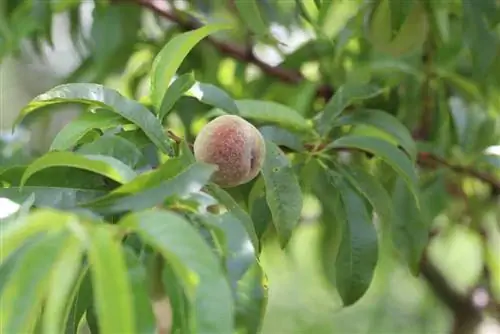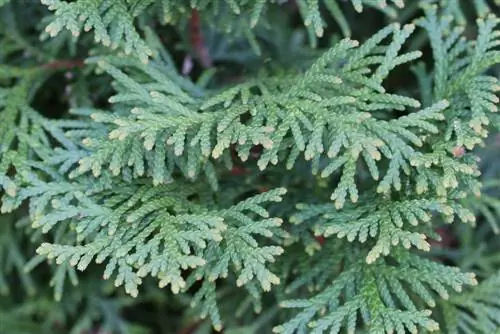- Author admin [email protected].
- Public 2023-12-17 03:39.
- Last modified 2025-06-01 06:48.
There are many types of roses to admire in the local gardens, as this graceful beauty has many fans among amateur gardeners. But care is not always easy, because the plant is often affected by the three rose diseases rose rust, powdery mildew and star sooty mildew. Then you have to act quickly. However, the infestation of these fungal diseases can be minimized if the right location is chosen and a few care instructions are followed. And curled leaves are also often a problem for these graceful beauties.
Fungal infections of the rose
The native roses in local gardens are often affected by fungal diseases, which can occur due to a lack of care or the wrong location. Therefore, the right location must be found before cultivation, where the diseases usually hardly or not at all occur. In addition, a rose bush should never be left to its own devices, because the plant needs regular care, which can also prevent one of the diseases from breaking out. Therefore, the following should be noted in advance:
- choose an airy location
- the rose needs enough space on all sides
- This ensures that rainwater dries quickly on the leaves
- never water from above
- just water on the leaves promotes the fungus
- Provide regular nutrients
- choose a good soil
- this makes the rose more resilient
- Don't over-fertilize roses, it's better to stick to the fertilizer manufacturer's instructions
- remove all old buds, flowers and immature, soft tissue before winter
Tip:
It is above all recommended that when choosing a rose variety, you should make sure that it belongs to the so-called ADR varieties. These were bred in such a way that they are said to be more robust, resilient and he althier than rose varieties that do not belong to this standard.
Definition rose rust
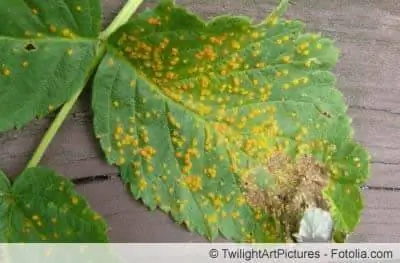
The graceful plants are also often affected by rose rust, also a fungal disease. Moisture is a good source of food for this fungus. A well-ventilated location is therefore a good measure because it allows the leaves to dry more quickly after rain. Even if the rose bushes are too close together, this provides a good basis for the rose rust. This can be recognized as follows:
- many rusty red or yellow-orange spots on the upper side of the leaf
- some dark edges around the spots
- If the infestation is severe, there is no longer any separation between the spots
- recognizable, elongated and prominent spores on the underside of the leaf
- more spores escape from these spore stores
- these are yellowish to dark
- are spread by the wind
- If the infestation is advanced, the leaves are thrown off
Tip:
Shrub roses in particular are at great risk because they are close to each other and therefore there is no good ventilation. Therefore, they should be thinned out regularly, especially in the crowns, so that they remain airy and loose and therefore more resilient.
Measures against rose rust
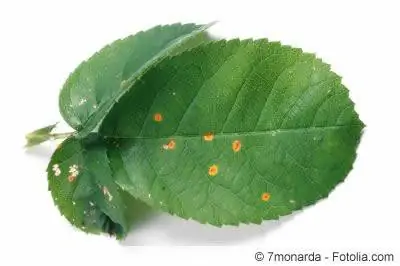
Rose rust must be treated as soon as it is detected. Because the wind spreads the spores quickly throughout the garden. The leaves that have already been shed can also cause further damage in the immediate vicinity of the affected roses. The spores found here are hardy and can immediately cause a new infection next year. Therefore, the following measures should be taken against rose rust:
- remove all fallen leaves from the ground immediately
- dispose of in household or residual waste
- Ideally work with gloves and put the leaves directly into a plastic bag
- close this well
- otherwise spores could detach and spread to nearby plants
- Do the same with the affected leaves on the bush
- Clean gloves thoroughly afterwards or dispose of them too
- If the rose bush is severely infested, cut it far down to the bottom
- Use fungicides from specialist retailers
- spray several times and repeat every seven to ten days
Tip:
Fungicides are usually well suited to stopping an infestation and preventing the further spread of a fungal disease. Home remedies, on the other hand, are usually of little help against the resistant and later life-threatening fungi for roses. Therefore, a fungicide should be used immediately, even if the chemical treatment is generally better avoided.
Definition curled leaves
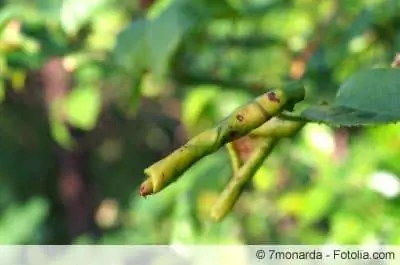
Rolled leaves on a rose are not a disease, but rather an infestation of the rose leaf wasp. If the leaves of the rose look similar in shape to a cigar, then an infestation by pests cannot be ruled out. The small insects themselves are often hardly noticed; due to their size of around four millimeters, they are not recognized because they look like small, black dots. The curled leaves usually appear as early as May as follows:
- The scroll sawflies fly between April and June
- they lay two to three eggs on the undersides of the leaves
- they also pierce the leaf
- the larvae hatch and feed on the leaves
- This causes the affected leaf to curl up
- measures against curled leaves
The curled leaves are not a life-threatening damage to the rose. But if the infestation is not combated, all of the leaves may be damaged, which does not benefit the appearance of the graceful plant. Therefore, the following should be done against sawflies:
- remove and dispose of rolled leaves
- Do not put in the compost, but with household or residual waste
- so the larvae are removed directly
- otherwise they would fall to the floor after a while
- here they can hide and pupate
- next year they will emerge as rose leaf roller wasps
- so they attack the surrounding roses again
- If you want to be on the safe side, renew the soil around the affected rose
- dispose of the removed soil completely and do not reuse it in the garden
Definition star sooty dew
One of the most common fungal diseases that can occur on roses is sooty mold. This can occur particularly strongly in years with damp and cool weather. The star sooty mold is direct and immediately obvious even to the inexperienced hobby gardener, because it shows itself through the following
Features:
- gray-black, irregularly shaped and differently sized spots
- these can also have radiating edges
- The leaves are usually discolored around the spots
- these discolorations appear yellow-red or just yellow
- If the roses are already heavily infested, the leaves are thrown off
- they are severely weakened by the illness
Measures against sooty mold
If it has been recognized that the rose is infected, action must be taken quickly. Otherwise the fungus will take hold and can spread to other plants in the garden. In particular, the fallen, infected leaves around the rose bush pose a great risk of spreading. This is how the fungus gets into the ground and can overwinter here. The problem of the infestation is therefore not solved by itself with the shedding of leaves and an approaching winter; the fungus will immediately reappear next spring if no action is taken. Therefore, the fallen leaves should be swept up and collected immediately. Under no circumstances should you put these in the compost; instead, dispose of them in household waste. If the star sooty mold gets into the compost via the rose petals, it will be distributed throughout the garden next year. When an infestation is first detected, the following procedure should be followed:
- Use a fungicide from a well-stocked store
- remove all affected leaves in advance and dispose of them in household waste
- pay attention to the manufacturer's instructions when using the fungicide
- three treatments seven days apart are usually recommended
- If the rose is already heavily infested, it should be cut back altogether
- it is radically cut down to the floor
- then use the fungicides, ideally treating the soil all around
Tip:
If the rose has already survived a sooty mold last year, preventive measures should be taken immediately next spring. As soon as the first leaves appear, they can be sprayed with homemade broth made from garlic, comfrey or horsetail several times within two weeks.
Definition powdery mildew
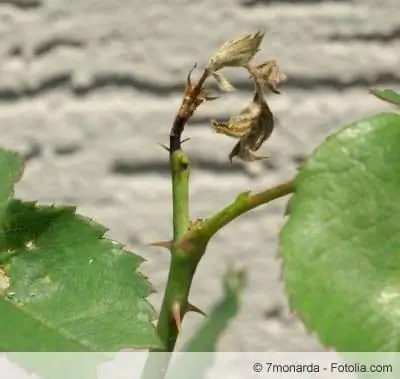
The fair-weather fungus is powdery mildew, which occurs much more frequently than downy mildew. Warm, humid weather in the hot summer months from June to August is particularly popular for powdery mildew to appear. Therefore, especially during these months, every hobby gardener is particularly encouraged to pay attention to changes in their roses. The infestation of powdery mildew can be recognized primarily by the following features:
- mold-like, whitish coating
- usually on the top of the leaves
- later spreads through flower stalks and buds
- there is a weaker coating on the undersides of the leaves
- Mildew is a fungus that forms permanent spores
- - not quite as infectious as rose rust or black sooty mildew
Tip:
The leaves that are infected with powdery mildew, as well as all other plant parts of the affected rose that are removed here, should never be added to the compost, but should always be disposed of as residual waste.
Measures against powdery mildew
Especially rose plants that have been given too much nitrogen-based fertilizer and which, for this reason, have many large, but also soft and thick leaves, are affected by powdery mildew. Because these leaves can offer little resistance to the fungus. Therefore, in this case of fertilizing, less is often more. It is usually sensible and recommended to always take preventative measures against this fungal infestation. For this purpose, commercially available sulfur preparations, such as “mildew-free” from the garden store, can be used. However, these no longer help if the plant has been attacked by powdery mildew. In the event of an acute infestation, the following procedure should be followed:
- Use commercial fungicides
- spray several times and don't forget the rose bush
- also give the floor around the same treatment
- repeat the treatment every seven to ten days
- remove and dispose of all affected leaves as well as buds and stems
- if there is a severe infestation, cut the rose back to the cane
Tip:
After removing the diseased areas, clean the used secateurs well and ideally disinfect them immediately so that the fungus is not passed on to other plants when they are cut.
Definition of downy mildew
Even if it sounds like it, the pathogens of downy mildew and powdery mildew have nothing in common, even if the symptoms of an infestation seem quite similar. Downy mildew appears primarily on the undersides of leaves. It is softer, fluffier and purple. Yellow or brown to dark discolorations appear on the leaf surface. These also appear on the flowers, stems and buds. Downy mildew occurs especially when there is a lot of moisture, usually in spring or autumn. Injured or weakened roses in particular are affected by the fungus if there is too much moisture.
Combatting downy mildew
If no measures are taken against downy mildew, the plant will eventually die and rot. The rotten parts, on the other hand, release the fungal spores so that they can be transferred to other plants. Therefore, the following steps should be taken to combat it as soon as downy mildew is first noticed:
- immediately remove all affected plant parts
- spray the plants and the surrounding area with fungicides
- repeat this after several days
Tip:
To ensure that all fungal diseases have been prevented, the commercially available fungicides with their different active ingredients can also be used alternately. This can ensure that all the different fungal diseases that may have been overlooked are successfully combated.
Conclusion
Rose rust, powdery mildew and star sooty mildew are the three diseases of roses that can take a toll on the graceful beauty. Leaf roller wasps also like to harm the rose. But if the plants are taken into account, not exposed to wild growth and properly cared for, as well as the right location, then the likelihood of illness is greatly reduced. But of course it can always happen that one or two rose bushes are attacked by a fungus in a very humid and wet summer. However, if action is taken quickly, hobby gardeners need not fear this. Because there are measures and means so that the rose will shine again in new splendor next year at the latest.


